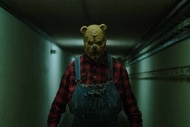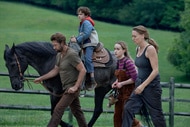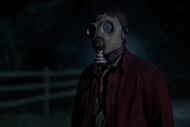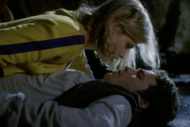Create a free profile to get unlimited access to exclusive videos, sweepstakes, and more!
Little Hope mixes Silent Hill with the Salem witch trials, to great effect

When I first booted up The Dark Pictures Anthology: Little Hope, the newest short-form interactive horror narrative from game developer Supermassive Games, I was caught a little off guard by how many varied and seemingly contradictory horror concepts the game was throwing around. With time-traveling examinations of the 17th-century witch trials, ideas about reincarnation and cyclical death, hints at a demonically possessed child, and a Silent Hill-inspired fog-drenched town that refuses to let you leave, Little Hope wastes absolutely no time throwing players right into the middle of a story that is, if nothing else, ambitious in its scope.
In Little Hope, players control a group of university students and their professor, whose bus crashes in the titular town after an unexpected detour. A mysterious fog pushes the group ever deeper into the town, as they experience flashbacks of people who share their faces slowly being put to death during the 17th-century witch trials. Players explore environments looking for clues as to what is happening, make choices about what the characters should say and do, and take part in quick time events to try and keep their party alive when attacked by monsters that share a striking similarity to the ways their counterparts in the past met their own grisly ends.
One thing I really enjoyed about Little Hope, compared to previous Supermassive games like Until Dawn and Man of Medan, was the variety of ages, body types, and personalities present in our group of playable characters. There's the shy and seemingly level-headed Andrew (played by actor Will Poulter), the typical horror movie jock with a heart of gold Daniel, and the stubborn and headstrong Taylor (whose short pixie haircut is great, by the way), as well as two older characters, recently sober alcoholic professor John and mature student Angela.
While all the performances in Little Hope were well handled, Angela was, for me, the stand-out star of the game. Her journey from stubborn intellectual who has a disdain for young adults and a refusal to believe in the supernatural into a hardy member of the group who came to trust those around her was really engaging. Little Hope did a terrific job of involving Angela in action scenes that made sense for her character's age and body type, plus giving her the ability to survive violent encounters without assistance. It was really nice seeing her ability to hold her own presented as determination to survive, and not simply frail and vulnerable.
Considering that the 17th-century witch trials were a real historical event in which many women and their defenders were needlessly put to death without due cause, I was curious going in how Little Hope, as a piece of horror fiction, would handle its depiction of history. The game doesn't shy away from the brutal ways that people were killed, or the ease with which innocent people could have doubts cast upon their innocence, but the fact that the game allows for a degree of intervention in the events can sometimes dilute its examinations of the real events. When you suggest supernatural occurrences were perhaps taking place in and around the witch trials, it muddies the fact that the real-world event consisted of largely needless killings built upon paranoia and suspicion.
If you've played previous Supermassive horror games, one really nice quality of life change is that the game now warns players with on-screen visual and audio prompts before any quick-time event prompt pops up. Any time Little Hope expects you to quickly press a button to jump over a ledge or avoid a lunging monster, you'll have a short window of warning to focus on the screen and look out for a prompt. These warnings also clue the player in on where to be looking for that button prompt, which makes quick-time events feel a lot fairer in the moment.
Additionally, Little Hope is very up-front with players as they go through the adventure about the emotional traits each of the characters has, which may cause problems for them if not corrected. A map of player personality traits, which can be seen at any time, lists tough-to-change character traits with a padlock symbol and displays an on-screen graphic to indicate whether a character choice has created a new personality trait of relevance to the player. Little Hope makes it pretty easy to understand the impact that your choices are having on who the cast of characters are, and just how set in their ways they have become. These choices are more relevant to the ending of Little Hope than some of Supermassive's past games, with some endings dependent on monitoring these aspects of the cast. The fact that the game is so transparent about these character attributes makes their ultimate importance feel justified.
While Little Hope initially feels a little cluttered with the sheer number of horror genres and influences it attempts to tackle, everything very much does come together by the end of the story. Although a couple of the introduced threads are red herrings, most of them come together when the plot reaches its conclusion. Where some previous Supermassive games have suffered from slightly predictable endings, Little Hope's big plot moment caught both me and my girlfriend on a first playthrough completely by surprise. It's the kind of plot reveal that had me instantly itching to play the game through a second time, looking for clues and hints as to what had been going on. In many ways, my second playthrough was more interesting than the first, with a bunch of granular questions about the plot slowly making sense as I experienced scenes with a fresh perspective. I think the plot's big moment largely lands and does an effective job of raising questions to ponder on and revisit.
Much like The Dark Pictures Anthology: Man of Medan before it, Little Hope features a couple of different ways to play the game. The game features a traditional single-player story mode, lasting around five hours, where players regularly switch among controlling each of the main characters interchangeably. The game also features Movie Night mode, where players in the same room can divide up the playable characters and pass the controller back and forth, and shared story mode, where two online players each play through half of the game's events.
With Man of Medan, I very much recommended players make their first playthrough of that game a Shared Story mode playthrough. By splitting up the players from each other, showing them different events, and then bringing them back together, that game created a few really memorable moments of horror that would not have worked as well in any other medium. I largely feel the same way about Little Hope. There is something added by splitting the players and hiding parts of the story from them, but Little Hope does have one slight issue when played in this online co-op mode. Without giving spoilers, I feel like the way the characters are divided up may cause one player to have a slightly more impactful first playthrough than the other. It's not a major difference, but there is a small variance in player experience depending on the characters they are dealt.
Of all the Supermassive games I have played, Little Hope is the one that most demanded I replay it after finishing the first playthrough. My urge to jump back in was less motivated by exploring the game's branching narrative paths and more to do with polishing my playthrough and seeing the clues to the horror mystery I had not seen the first time through.
If you're someone with an interest in horror, as well as the idea of a story that crosses the Salem witch trials with Silent Hill, Little Hope will likely be for you. Be prepared for the ending to give you a bit of a roller coaster of thoughts about the game that preceded it, and probably give yourself time for a second playthrough, but there's a really cool horror video game here worth diving into.






























